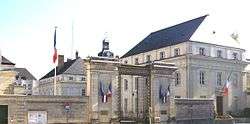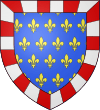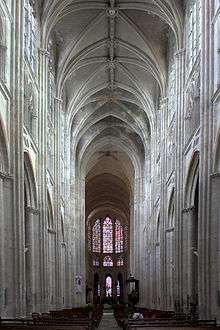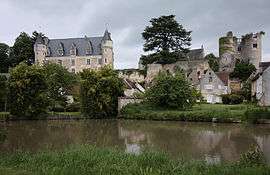Indre-et-Loire
| Indre-et-Loire | |||
|---|---|---|---|
| Department | |||
|
Prefecture building of the Indre-et-Loire department, in Tours | |||
| |||
 Location of Indre-et-Loire in France | |||
| Coordinates: 47°15′N 0°40′E / 47.250°N 0.667°ECoordinates: 47°15′N 0°40′E / 47.250°N 0.667°E | |||
| Country | France | ||
| Region | Centre-Val de Loire | ||
| Prefecture | Tours | ||
| Subprefectures |
Chinon Loches | ||
| Government | |||
| • President of the General Council | Marisol Touraine (Socialist Party) | ||
| Area1 | |||
| • Total | 6,127 km2 (2,366 sq mi) | ||
| Population (2013) | |||
| • Total | 600,252 | ||
| • Rank | 41st | ||
| • Density | 98/km2 (250/sq mi) | ||
| Time zone | CET (UTC+1) | ||
| • Summer (DST) | CEST (UTC+2) | ||
| Department number | 37 | ||
| Arrondissements | 3 | ||
| Cantons | 19 | ||
| Communes | 277 | ||
| ^1 French Land Register data, which exclude estuaries, and lakes, ponds, and glaciers larger than 1 km2 | |||
Indre-et-Loire (French pronunciation: [ɛ̃dʁ‿e lwaʁ]) is a department in west-central France named after the Indre and the Loire rivers.
History
Indre-et-Loire is one of the original 83 departments created during the French Revolution on 4 March 1790. It was created from the former province of Touraine.
Tours, the departmental prefecture, was a centre of learning in the early Middle Ages, having been a key focus of Christian evangelisation since St Martin became its first bishop in c. 375. From the mid-15th century, the royal court repaired to the Loire Valley, with Tours as its capital, and at the confluence/crossing-point of the Loire and Cher rivers it became a centre of silk manufacturing and other luxury goods, including the wine-trade, creating a prosperous bourgeoisie.
After the creation of the department it remained politically conservative, as Honoré de Balzac recorded in several of his novels. Conservative Tours refused to welcome the railways which instead were obliged to route their lines by way of Saint-Pierre-des-Corps on the city's eastern edge. The moderate temper of the department's politics remained apparent after the Franco-Prussian War of 1870: sentiments remained predominantly pro-royalist during the early years of the Third Republic.
For most of the nineteenth century, Indre-et-Loire was a rural department, but pockets of heavy-duty industrialisation began to appear towards the century's end, accompanied by left-wing politics. 1920 saw the birth of the French Communist Party at the Congress of Tours. By 1920 Saint-Pierre-des-Corps had become a major railway hub and a centre of railway workshops: it had also acquired a reputation as a bastion of working class solidarity.
Geography
Indre-et-Loire is part of the current region of Centre-Val de Loire and is surrounded by the departments of Loir-et-Cher, Indre, Vienne, Maine-et-Loire, and Sarthe.
Politics
The President of the General Council is Marisol Touraine of the Socialist Party.
| Party | seats | |
|---|---|---|
| • | Socialist Party | 18 |
| Miscellaneous Right | 8 | |
| Union for a Popular Movement | 5 | |
| • | Miscellaneous Left | 2 |
| New Centre | 2 | |
| • | French Communist Party | 1 |
Tourism
Indre-et-Loire is home to numerous outstanding châteaux that are open to the public, among them are the following:
- Château d'Amboise
- Château of Azay-le-Rideau
- Château de la Bourdaisière
- Château de Chenonceau
- Château de Chinon
- Château de la Guerche
- Château de Langeais
- Château de Loches
- Château de Marçay
- Château de Montpoupon
- Château de Plessis-lez-Tours
- Château du Rivau
- Château de Tours
- Château de Villandry
See also
- Cantons of the Indre-et-Loire department
- Communes of the Indre-et-Loire department
- Arrondissements of the Indre-et-Loire department
External links
- (French) Prefecture website
- (French) General Council website
- (English) Indre-et-Loire at DMOZ
- (French) Official tourist website of Touraine Loire Valley







